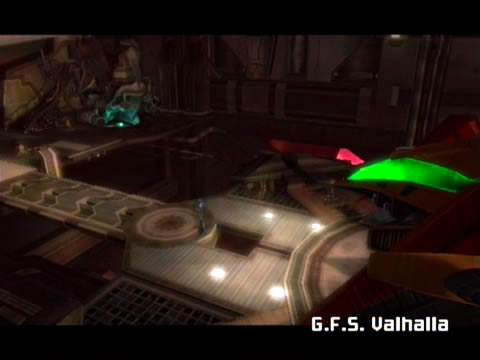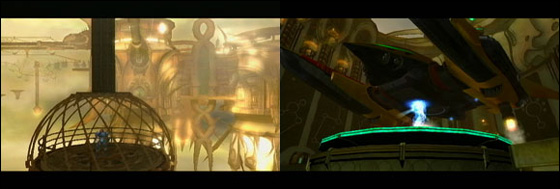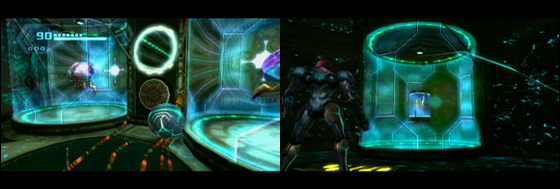Metroid Prime 3: Quarterly Diaries #7
October 15th, 2009

Areas Covered: Imperial Caverns, GFS Valhalla, Skytram East, Sky Town
Discussion Points: Scrambled radio message and the random detour to GFS Valhalla, Skytram East’s level design, Phazon Metroid initial set piece
Imperial Caverns
Imperial Caverns has a beautiful calmness to it that really reflects on the area’s seclusion from the rest of the planet as well as the player’s quietening journey deeper into the environment. At about the most ambient point in the journey, a scrambled radio signal bursts out of your speaker—scaring the living daylights out of you and totally breaking the mood. Like all radio chatter it’s played over gameplay so it totally creeps up on the player.
Back in Bryyo you find out that it was the always intrusive Galactic Federation. Supposedly they lost your connection because of the warp point. In worried exasperation the respective Aurora Unit explains the reasons for static before pointing Samus to the abandoned GFS Valhalla. Another spot will open on the galaxy map, so away we go.
GFS Valhalla
GFS Valhalla was overrun by the space pirates and sits in a desolate sphere of space as a lonesome carrier for renegade pirates and other creatures. The visual tone of the area is typically brooding with a slick dark black and rich red aesthetic. The handful of enemy creatures still around put up an admittedly tough challenge, really puts you on edge and gives the atmosphere a sharp taste.

I have no idea why we were sent here though. The explanation put forward on Bryyo was simply that the place warranted investigation yet the abandoned wreck at this stage in the game has no use. After some quick exploration you’ll realize that you need four or five energy cells to re-power the station, but we don’t have the energy cells, and in fact won’t acquire any until the next area of the game! I can’t find the justification for sending you out here, particularly when the player already has an idea regarding the next point of passage (screw attack pads in Sky Town). The whole sequence, including the radio static, feels preempt, misplaced and unecessary—a red herring?
Skytram East
After screw-attacking your way up to the rather funky sky tram (everything in this area is so elegantly designed!), you arrive at the next portion of Elysia. The level design of this area is tightly interwoven and if you become too analytical (like me!) it’ll probably become confusing. The trick is to just follow your senses though, it’s all very straightforward.
Essentially, this area houses a series of bomb parts which will later be assembled and then dropped on the leviathan shield which’ll open up access to Elysia’s seed ie. the boss for this area. The player requires three things from this area: the ‘ship grapple’ upgrade (to lift the various components) and the first two individual bomb components. Acquiring the upgrade is obviously your first priority and to do that the player simply needs to make a linear trek to the opposite side of the map. The linear swing around the right-hand side works to introduce the general layout of the area, which is quite necessary given that the clump of floors in and around the three main centres can be particularly daunting. On the first romp not everything is accessible yet, which compartmentalizes your route nicely to lower areas of the map and keeps everything manageable, while at the same time teasing the unreachable areas. There’s a lot of smart layering in this section as the ship upgrade and seeker missiles manage the flow of access.

Once you reach the end and power-up your ship, the two components can be obtained in order of closest to furthest out from the end point; the design folds, accommodating the route reversal. Unfortunately the triangular, three-point design may mislead players to take the wrong route, but if you abide by the closest-to-furthest principle the design won’t pose any problems.
The ship grapple is used initially to lift a projector (large, circular mass) in the Chozo Observatory, doing so reveals a faulty circuit. Fix the circuit, drop the projector back in place and you’re given access to the upper floors. Eventually the upper route will overlap some with the route you originally took on the way in, concluding at the Concourse centre. Again we see Retro organically making clever use of the level design by interlocking different sections and having them feed into one another. I discussed this to death in the previous article, it’s prevalent throughout the series and a great design philosophy as it gives new purpose to borrowed material and allows the area to be exploited entirely by the player. In this case, by concluding at the Concourse centre the player has travelled in full circle and now has a thorough understanding of the environment. It’s makes play meaningful and this matters.
As for the room-by-room design, I think the three hub areas (centres) and the multiple floors and corridors which immediately stream off these areas are most interesting because they encompass a visual and structural design which feels very unified. This helps the level design too feel structured and organised, even though it’s all rather elaborate and could be entirely unwieldy.
Stepping back for a moment, there’s an offshoot area before the 2nd bomb component which leads to a Metroid research laboratory. This is the first time we’ve seen the nasty face rippers in Metroid Prime 3—and there’s a great sense of tension that builds up as you walk past the glass tubes of Phazon Metroids, a breed new to the series. You worm your way into the depths of this laboratory in search of the seeker missiles knowing all too well that soon these Metroids will break loose and trap you inside.* You know that the game is leading you down the garden path and it’s a real tension builder. The music is set perfectly and the transparent panels are good at making you feel cased into this danger zone, where the danger itself is highly visible.

On reaching the end point, Samus must depower a shield to access the seeker missiles. Doing so will switch off the security measures and free the Metroid’s from their cylindric cages. I guess you gotta compromise, so you grab the seeker missiles and leave. The lights are out and only the surrounding alien hues provide sufficient light. The transparent flooring highlights trails of Phazon Metroids rushing their way to flank you at the exit. You literally see them scurry under the floor beneath you. There’s a wonderful feeling of dread and tension in the air. I rather enjoyed this moment, it has a typically implicit way of communicating meaning to the player which is very much traditionalist Metroid.
*You know so because Retro drop subtle clues which the player may or may not gather, and this is why I have so much respect for Retro Studios. Other developers in this industry would at this point hold up a huge sign saying “AND NOW WE’RE SETTING UP AN UBER COOL SET PIECE, I HOPE YOU’RE READY, IT’S GONNA BE AWESOME, BY THE WAY I’M THE GAME DESIGNER”. Metroid is and will always be a mature and engrossing experience simply because it respects the player by assuming that they can actually think for themselves. The developers don’t need to connect the dots or pre-boast about a forthcoming event with pretension that demeans the player. I admire games that do this and I hope to talk about it a little more in future writing.
Sky Town
After obtaining the second bomb component, the ship heads off to send supplies elsewhere and you make your way back to the Sky Town for the last part which is located in the Transit hub which we spotted on the way in. The component is locked in place and requires the seeker missiles to break from its lock. Now we have all of the upgrades for this area, bar the spider ball which we don’t get until later.
Additional Readings
Metroid Prime 3 Wikitroid Entry



 Game Design Companion: A Critical Analysis of Wario Land 4 - $7.99
Game Design Companion: A Critical Analysis of Wario Land 4 - $7.99 Level Design: Processes and Experiences
Level Design: Processes and Experiences Speed Boost: The Hidden Secrets Behind Arcade Racing Design - $5.99
Speed Boost: The Hidden Secrets Behind Arcade Racing Design - $5.99 Adventures in Games Analysis: Volume I - $5.99
Adventures in Games Analysis: Volume I - $5.99







